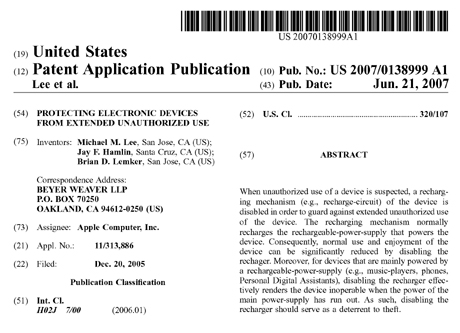New Apple patent disables iPhone's recharge function for unauthorized use

A newly published Apple patent contains technology that would be able to disable the iPhone (as well as other devices) by disabling the unit's recharging function if unauthorized use was suspected.
This App is entitled: Protecting electronic devices from extended unauthorized use
The Patent Abstract hints at this capability:
When unauthorized use of a device is suspected, a recharging mechanism (e.g., recharge-circuit) of the device is disabled in order to guard against extended unauthorized use of the device.
The recharging mechanism normally recharges the rechargeable power-supply that powers the device. Consequently, normal use and enjoyment of the device can be significantly reduced by disabling the recharger.
Moreover, for devices that are mainly powered by a rechargeable power-supply (e.g., music-players, phones, (my boldface) Personal Digital Assistants), disabling the recharger effectively renders the device inoperable when the power of the main power-supply has run out. As such, disabling the recharger should serve as a deterrent to theft.
So how would this be accomplished, exactly? I had a feeling you were going to ask me that.
Figure 2, and the accompanying text, cuts to the chase.
Initially, it is determined (202) whether potential unauthorized use of the device can be suspected based on one or more criteria (e.g., an event, condition, or situation) that indicate potential unauthorized use of the device. As noted above, an event, condition, or situation can, for example, be the expiration of a timer, connection or communication with another object (e.g., another device, adaptor, server), or locating the device outside of defined geographical region.
Accordingly, if unauthorized use is suspected (202), the recharger is disabled (204) so that the recharger cannot charge the rechargeable-power-supply. Subsequently, it is determined (208) whether use of the device can be authorized.
The use of device can, for example, be authorized by requiring a security-code to be entered, requiring that the device be connected to a known device, or moving the device back to a geographical boundary.
If it is determined (210) that the use of the device is authorized, the recharger is enabled (212) so that it can recharge the rechargeable-power-supply. Thereafter, the device-protection method 200 proceeds to determine (202) whether unauthorized use of the device is suspected and proceeds in a similar manner as discussed above.
However, if it is determined (208) that the use of the device cannot be authorized, it is determined (210) whether to allow reauthorization (e.g., allow reentering of a security-code).
If it is determined (210) to allow reauthorization, the authorized use of the device is determined (208). As a result of the reauthorization, the recharger may be enabled (212). However, if no reauthorization is allowed (210), the device-protection method 200 ends and the recharger is left disabled rendering the device inoperable when the recharger that powers the device eventually runs out.
